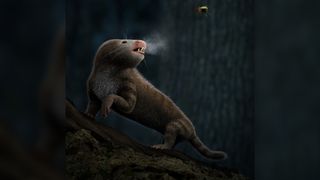Scientists pinpoint the exact moment in evolutionary time when mammals became warm-blooded
And it happened much more quickly than scientists expected.

Scientists have pinpointed the moment in time our earliest ancestors evolved to be warm-blooded, and it happened much later and far more quickly than the researchers expected.
The discovery, made by studying the minuscule tubes of the inner ear, places the evolution of mammalian warm-bloodedness at around 233 million years ago — 19 million years later than scientists previously thought.
These semicircular canals are filled with a viscous fluid, called endolymph, that tickles tiny hairs lining the canals as the fluid sloshes around. These hairs transmit messages to the brain, giving it instructions for how to keep the body balanced. Like some fluids, the honey-like endolymph gets runnier the hotter it is, requiring the semicircular canals to change their shape so the fluid can still do its job. In ectothermic, or cold-blooded, animals, this ear fluid is colder and thus behaves more like molasses and needs wider spaces in which to flow. But for endothermic, or warm-blooded, animals, the fluid is more watery and small spaces suffice.
Related: Ancient toothless 'eel' is your earliest known ancestor
This temperature-based property makes tiny, semicircular canals a perfect place to spot the moment when ancient mammals' cold blood turned hot, researchers wrote in a paper published July 20 in the journal Nature.
"Until now, semicircular canals were generally used to predict locomotion of fossil organisms," study co-lead author Romain David, an evolutionary anthropologist at the Natural History Museum in London, said in a statement. "However, by carefully looking at their biomechanics, we figured that we could also use them to infer body temperatures.
"This is because, like honey, the fluid contained inside semicircular canals gets less viscous [syrupy] when temperature increases, impacting function," David explained. "Hence, during the transition to endothermy, morphological adaptations were required to keep optimal performances, and we could track them in mammal ancestors."
Sign up for the Live Science daily newsletter now
Get the world’s most fascinating discoveries delivered straight to your inbox.
To discover the time of this evolutionary change, researchers measured three inner ear canal samples from 341 animals — 243 living species and 64 extinct species — spanning the animal kingdom. The analysis revealed that the 54 extinct mammals included in the study developed the narrow inner ear canal structures suitable for warm-blooded animals 233 million years ago.
Before this study, scientists thought mammals inherited warm-bloodedness from the cynodonts — a group of scaly, rat-like lizards that gave rise to all living mammals — that were thought to have evolved warm-bloodedness around the time of their first appearance 252 million years ago. However, the new findings suggest that mammals diverged from their early ancestors more markedly than expected.
And this drastic change happened surprisingly fast. Heat-friendly ear canals didn't just appear later in the fossil record than the scientists expected. It happened far more rapidly, too — popping up around the same time the earliest mammals began evolving whiskers, fur and specialized backbones.
"Contrary to current scientific thinking, our paper surprisingly demonstrates that the acquisition of endothermy seem[s] to have occurred very quickly in geological terms, in less than a million years," study co-lead author Ricardo Araújo, a geologist at the University of Lisbon in Portugal, said in the statement. "It was not a gradual, slow process over tens of millions of years as previously thought, but maybe was attained quickly when triggered by novel mammal-like metabolic pathways and origin of fur."
Follow-up studies will need to confirm the findings via other means, but the researchers said they are excited that their work will help to answer one of the longest-standing questions about the evolution of mammals.
"The origin of mammalian endothermy is one of the great unsolved mysteries of paleontology," study senior author Kenneth Angielczyk, the Field Museum's MacArthur curator of paleomammalogy, said in the statement. "Many different approaches have been used to try to predict when it first evolved, but they have often given vague or conflicting results. We think our method shows real promise because it has been validated using a very large number of modern species, and it suggests that endothermy evolved at a time when many other features of the mammalian body plan were also falling into place."
Originally published on Live Science.

Ben Turner is a U.K. based staff writer at Live Science. He covers physics and astronomy, among other topics like tech and climate change. He graduated from University College London with a degree in particle physics before training as a journalist. When he's not writing, Ben enjoys reading literature, playing the guitar and embarrassing himself with chess.
